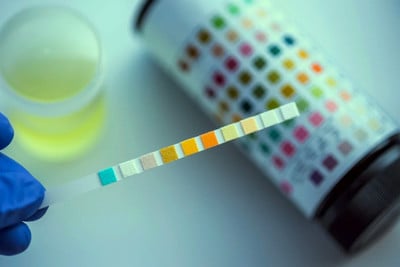.

What Is THC-COOH And Why Do Drug Tests Screen For It?
Nearly everyone who uses cannabis is familiar with tetrahydrocannabinol, or THC. But do you know about THC-COOH and how it factors into modern day drug testing?
Contrary to popular belief, standard drug tests don’t actually test for the THC in cannabis. Rather, they screen for a metabolite THC creates within the human body, THC-COOH. The main reason? It stays in your body way longer than THC does.
WHAT IS THC-COOH?
THC-COOH is the most common name for this metabolite, but its official name is 11-nor-9-carboxy-Δ⁹-tetrahydrocannabinol and it’s read "carboxy THC”. It’s also commonly referred to as 11-nor-9-carboxy-THC or THC-11-oic acid. It’s the second metabolite of THC that’s formed in the human body after cannabis is used, regardless of the consumption method, right after hydroxy-THC (11-hydroxy-Δ9-tetrahydrocannabinol).
THC-COOH is not water-soluble; it’s lipid-soluble and stored in our fat cells. Because of this, it stays in the system much longer than other substances. The THC itself leaves the system relatively quickly, within hours usually. However, it’s not uncommon for THC-COOH to be detectable for weeks after your last hit.
SPECIFIC DIFFERENCES BETWEEN THC AND THC-COOH
When people talk about “getting stoned”, “blazing”, or “getting high”, they’re talking about the psychoactive effects of THC, the most prominent cannabinoid found in the cannabis plant. THC-COOH, on the other hand, doesn’t induce any psychoactive effects whatsoever. It’s basically just part of the body’s response to THC exposure. Unfortunately, as mentioned above, it stays in the system much longer than THC.
In appearance, THC is a dark gold or deep amber-colored substance. It’s hard and solid when cold, but when warmed it becomes tacky and adherent. As mentioned above, it’s fat-soluble, so its metabolites are not only stored in the body for a long time, but it’s also metabolised completely differently than a water-soluble substance.

METABOLISM AND DETECTION
THC-COOH is formed when liver enzymes oxidise hydroxy-THC. It’s the main metabolite tested for in urine and blood screenings due to its long half-life. Newer, more expensive drug tests can differentiate[1] between hydroxy-THC and THC-COOH, but these tests are used sparingly to determine if and how recently cannabis was used, at a DUI checkpoint, for example.
If only THC-COOH is detected, that means a cannabis product was consumed a while ago and there is no chance the user is still impaired. If both THC and THC-COOH are detected, then it’s highly likely that cannabis was consumed within the last few hours. THC, hydroxy-THC, and THC-COOH can all be comparatively detected with a blood test, ie. blood cannabis level.
This is uncommon though, and usually drug tests will only pick up on THC-COOH, which can be found via blood test, urine sample, saliva, and breathalyzer. For people who use cannabis regularly, this causes a great deal of inconvenience since it stays in the system for weeks after use. This means you could fail a drug test for a job, probation, or roadside sobriety check even if it’s been 3 or 4 weeks since the last time you smoked (or vaped, ate an edible, etc.).
ELIMINATION FROM THE BODY
According to a recent study[2] that monitored cannabis users during a 30-day period of abstinence, “The greater the creatinine corrected initial THC-COOH concentration, the greater the interval until the first negative and last positive specimens, the greater the window of drug detection and the higher the detection rate of positive specimens. Cannabis users who present with an initial normalized THC-COOH concentration >150 ng/mg can be expected to have detection rates between 60 and 100% for 28 days after the first negative urine test”.
In other words, the more you smoke, the longer THC-COOH will stay in your system. In all reality, it’s useful information for everyone involved. The smoker can estimate about how long the cannabis will stay in their system, and they can take a home test to verify. Whoever is administering the test can use this info to possibly differentiate between a new and/or occasional user and a regular, heavy user.
Some people choose to speed up the process by diluting their urine, taking zinc supplements, drinking cranberry juice, or buying drinks specifically made for weed detox. However, none of these methods are 100% effective. The only way to be clean for sure is to stop using for a certain period of time.

FINAL THOUGHTS
If there’s anything to take away from this article, it’s that most drug tests ARE NOT looking for THC; they’re going to pick up on the THC-COOH in your body. So keep in mind that if you’re a daily smoker, you may want to quit for around 4–6 weeks before any scheduled drug screening. If you only smoke occasionally, it should be out of your system in about a week.
- Untitled Page https://ccmta.ca
- Urinary Elimination of 11-Nor-9-carboxy- 9-tetrahydrocannnabinol in Cannabis Users During Continuously Monitored Abstinence https://www.ncbi.nlm.nih.gov









































